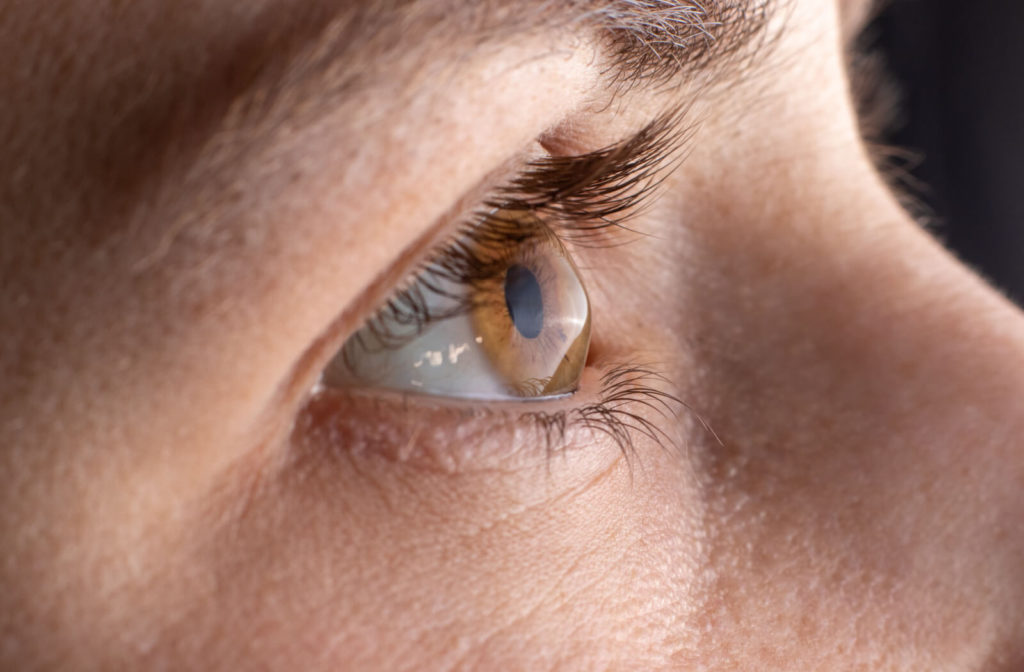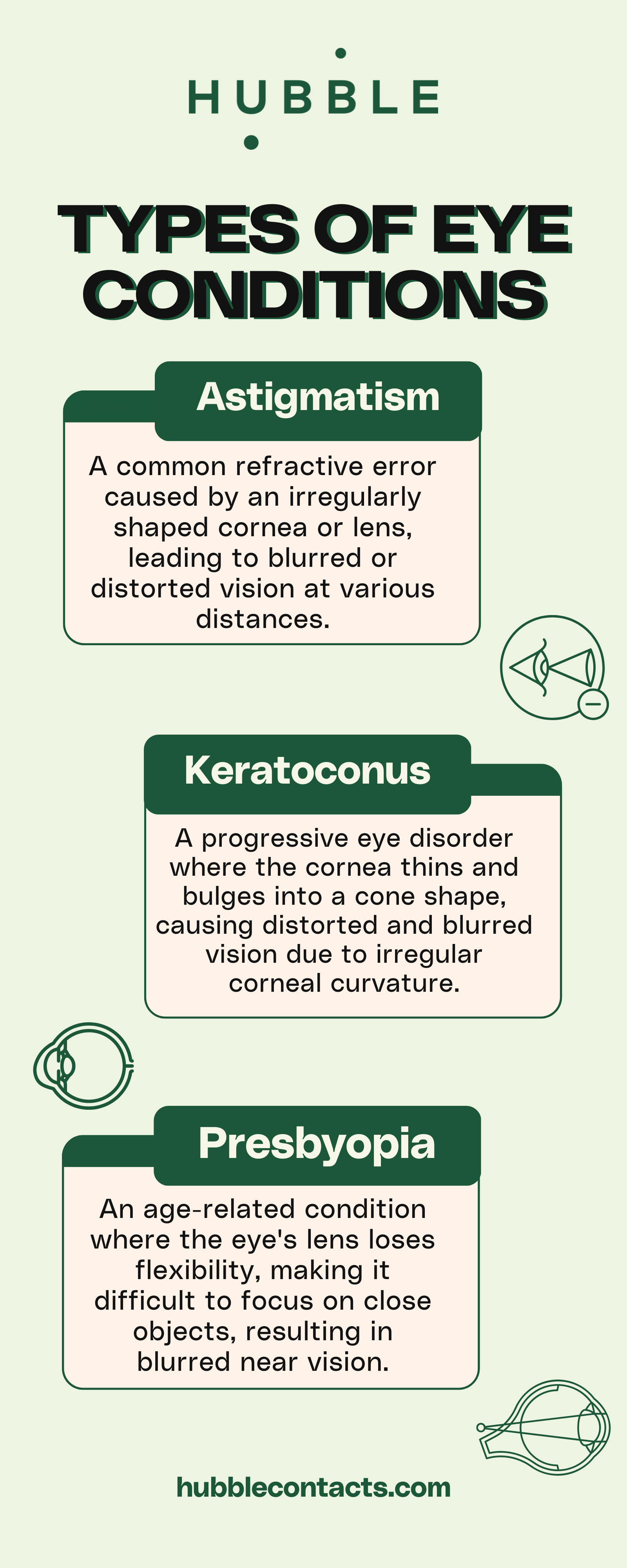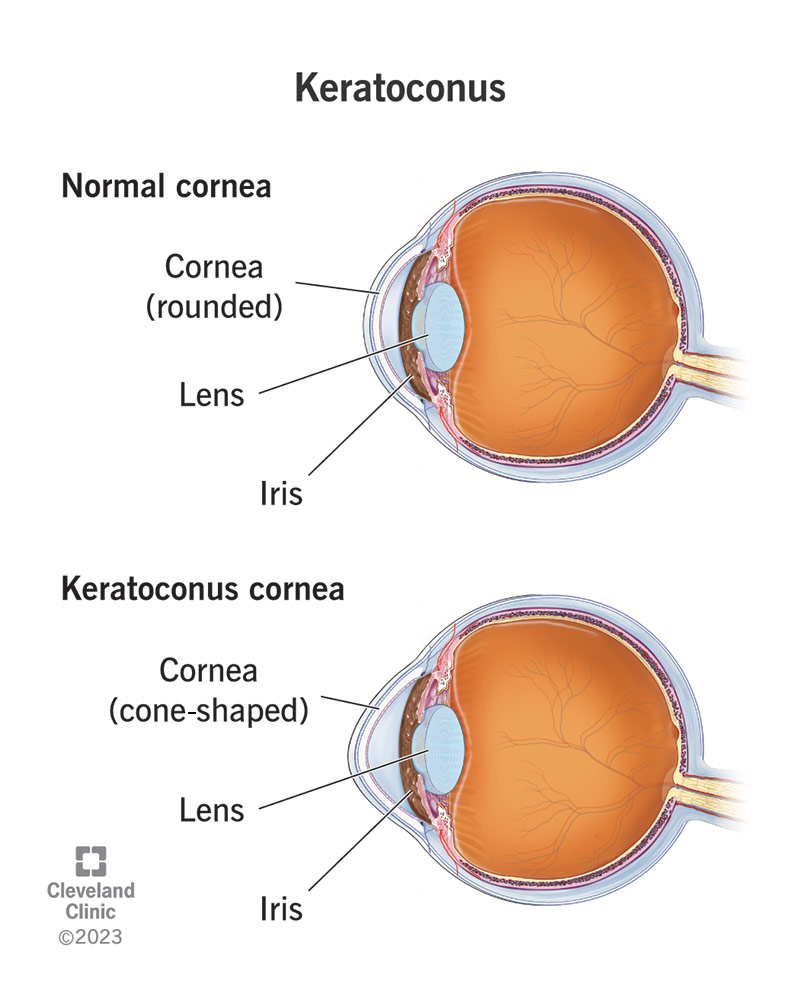Contact lenses come in various shapes to fit different eye conditions. One unique design is the cone shape.
This shape is especially beneficial for those with specific eye issues. Understanding the contact lens cone shape is crucial for finding the right fit. This special design helps manage conditions like keratoconus, a disorder where the cornea thins and bulges into a cone shape.
These lenses are crafted to provide comfort and clarity for affected individuals. They offer a customized fit that standard lenses might not provide. In this blog, we will explore the importance of cone-shaped contact lenses, how they work, and who can benefit the most from them. Dive in to learn how these lenses can improve your vision and quality of life.
Introduction To Contact Lens Cone Shape
Contact lenses are small, curved pieces of plastic. They correct vision. The shape of these lenses is crucial. It affects comfort and vision clarity. The cone shape is one of the most important shapes. Understanding it can help in selecting the right lens.
Importance Of Shape
The shape of a contact lens directly impacts its fit. A proper fit ensures comfort and good vision. Ill-fitting lenses can cause discomfort and eye problems. The cone shape is designed to match the natural shape of the eye. This reduces irritation and provides better vision.
There are several aspects to consider:
- Base Curve: The curve of the lens that sits on the eye.
- Diameter: The size of the lens edge to edge.
- Thickness: How thick or thin the lens is.
These factors combined determine how well the lens fits. A well-fitting lens will feel almost invisible. It will also provide clear, stable vision.
Historical Context
Contact lenses have a long history. The idea dates back to Leonardo da Vinci. He sketched the first ideas in 1508. But real progress began in the 1800s. Glass contact lenses were the first to be used.
In the 1950s, plastic lenses were developed. They were lighter and more comfortable. The cone shape became more refined. Scientists studied the eye's natural shape. This led to better fitting lenses.
Today, modern lenses are made with advanced materials. They are designed to fit the eye perfectly. The cone shape remains crucial. It ensures comfort and clear vision for millions of users.

Credit: pinnacleeyecare.com
Benefits For Vision Clarity
Contact lenses with a cone shape offer significant advantages for vision clarity. These benefits can help those with various vision problems. Let's explore some key benefits.
Enhanced Focus
Contact lenses with a cone shape provide enhanced focus. They correct vision by adjusting the light entering your eyes. This leads to a clearer and more focused view.
With these lenses, you will notice improved sharpness. Daily activities like reading and driving become easier. The lenses ensure your vision stays clear throughout the day.
Reduced Distortions
One major benefit is the reduction of distortions. Regular lenses might cause blurred edges or halos. Cone-shaped lenses minimize these issues.
These lenses offer a more accurate view. They reduce visual aberrations and enhance overall clarity. This is particularly beneficial for people with astigmatism.
Comfort Improvements
Contact lenses have seen significant advancements in recent years. One notable improvement is in the comfort of lenses, which has been enhanced by the introduction of cone-shaped designs. These designs not only fit better but also provide numerous benefits for the wearer.
Reduced Eye Strain
The cone shape of modern contact lenses distributes pressure evenly across the surface of the eye. This reduces the likelihood of eye strain. Traditional lenses can cause discomfort due to uneven pressure. The cone shape helps to eliminate this issue.
Additionally, the improved fit means fewer adjustments. Wearers experience less irritation. This leads to a more comfortable experience.
Increased Wearing Time
With the enhanced comfort provided by cone-shaped lenses, users can wear their contacts for longer periods. This is especially beneficial for those who need to wear lenses all day.
Here are some benefits of increased wearing time:
- Less need for breaks
- Improved daily productivity
- Better overall eye health
The design allows for better oxygen flow to the eye. This reduces dryness and discomfort.

Credit: www.hubblecontacts.com
Materials And Design
The quality of contact lenses depends on their materials and design. Advances in these areas improve comfort and vision. This section explores innovative materials and advanced design techniques in contact lenses.
Innovative Materials
Modern contact lenses use various materials to enhance comfort and durability. Silicone hydrogel is a popular choice. It allows more oxygen to reach the eye. This reduces dryness and irritation.
Another material is hydrogel. It's softer and more flexible. People with sensitive eyes often prefer it. Some lenses also use gas-permeable materials. These provide sharper vision for specific eye conditions.
| Material | Benefits |
|---|---|
| Silicone Hydrogel | High oxygen permeability, reduces dryness |
| Hydrogel | Softer, more flexible |
| Gas-Permeable | Sharper vision, durable |
Advanced Design Techniques
Design techniques focus on enhancing lens comfort and fit. One technique is the use of aspheric lenses. These lenses reduce distortions and improve vision quality.
Another technique is toric design. It helps correct astigmatism. Multifocal lenses are also popular. They provide clear vision at different distances. Edge design is crucial too. Thinner edges improve comfort and reduce lens movement.
- Aspheric lenses: Reduce distortions
- Toric lenses: Correct astigmatism
- Multifocal lenses: Clear vision at all distances
- Thinner edges: Enhanced comfort
Types Of Cone Shaped Lenses
Contact lenses come in various shapes and designs to suit different needs. Cone shaped lenses are particularly useful for certain eye conditions. Understanding the types of these lenses can help you make informed choices.
Soft Lenses
Soft lenses are flexible and comfortable. They conform easily to the shape of your eye. These lenses are made from hydrogel or silicone hydrogel. This allows them to retain moisture. They are great for people with dry eyes.
Soft lenses are also easier to adapt to. Most users find them comfortable from the first use. They are available in daily, weekly, or monthly disposables. This makes them convenient for many lifestyles.
Rigid Gas Permeable Lenses
Rigid Gas Permeable (RGP) lenses are more durable. They are made from a firm material that allows oxygen to pass through. This helps keep your eyes healthy. RGP lenses provide clearer vision compared to soft lenses.
These lenses are also custom-fitted to your eyes. They can correct a variety of vision problems. While they might take longer to get used to, their benefits often outweigh this. RGP lenses need proper cleaning and care. They usually last longer than soft lenses.
Fitting And Customization
Contact lenses have evolved over the years. They now offer more comfort and better vision correction. A key part of this improvement is fitting and customization. Ensuring the lenses fit well is crucial for both comfort and eye health. Customization helps to meet individual needs and preferences.
Personalized Fitting
Every eye is unique. A personalized fitting ensures the contact lens matches the shape of your eye. This process involves an eye exam. The optometrist measures the curvature of your cornea. They also assess your tear film. These details help to choose the right lens size and type. A proper fit reduces discomfort. It also prevents potential eye issues.
Customization Options
Customization options enhance the contact lens experience. They can include different materials. Some lenses are softer, while others are more rigid. You can also choose lenses with different moisture levels. This helps keep eyes hydrated and comfortable. There are also options for different wear schedules. Some lenses are for daily wear. Others can be worn overnight or for extended periods.
Color options are also available. They can enhance or change your eye color. This adds a personal touch. Custom tints can also help with light sensitivity. These options make contact lenses more versatile and suited to your needs.
Care And Maintenance
Proper care and maintenance of contact lenses are essential for eye health. Following simple steps can prevent infections and discomfort. This section covers cleaning, storage, and general care tips for cone-shaped contact lenses.
Cleaning Tips
Always wash your hands before handling lenses. Use a mild, fragrance-free soap.
Rinse your lenses with a recommended solution. Avoid using water or saliva.
Gently rub the lenses with your fingers to remove debris. Rinse again with the solution.
Repeat this process for each lens.
Storage Guidelines
Use a clean lens case. Replace it every three months.
Fill the case with fresh solution. Never reuse old solution.
Ensure lenses are fully submerged. This prevents drying out and contamination.
Store the case in a cool, dry place. Avoid direct sunlight.
General Care Tips
- Do not wear lenses longer than recommended.
- Avoid wearing lenses while sleeping unless prescribed.
- Regularly visit your eye doctor for check-ups.
- Keep nails short to avoid damaging lenses.
Following these guidelines ensures the longevity of your cone-shaped contact lenses and maintains optimal eye health.
Common Issues And Solutions
Contact lenses with a cone shape can offer great vision correction. But they also come with some challenges. Users often face issues like discomfort and vision problems. Understanding these common issues and their solutions can help maintain healthy eyes and clear vision.
Handling Discomfort
Discomfort from contact lenses is a common problem. It can result from a poor fit or dry eyes. To reduce discomfort, make sure your lenses fit properly. Visit your eye doctor regularly to ensure the correct fit. Also, use lubricating eye drops. These drops keep your eyes moist and reduce irritation.
Clean your lenses regularly. Proper cleaning removes debris and protein buildup. This can also help reduce discomfort. If discomfort persists, consult with your eye doctor. They may recommend a different type of lens.
Managing Vision Problems
Some users may experience blurred vision with cone-shaped lenses. This can happen if the lens moves out of place. To fix this, ensure your lenses are the right size. Regular check-ups with your eye doctor can help ensure a proper fit.
Another cause of vision issues can be lens deposits. These deposits can blur vision. Clean your lenses daily to prevent this. If vision problems continue, talk to your eye doctor. They might suggest a different lens design.
Lastly, follow the recommended wearing schedule. Over-wearing lenses can lead to vision problems. Give your eyes a break to stay healthy and maintain clear vision.
Future Trends
Contact lenses have evolved significantly over the years. The shape of contact lenses, especially cone-shaped lenses, is seeing exciting changes. Let's explore the future trends in this area.
Technological Advances
Advancements in technology are changing contact lenses. Smart lenses with embedded sensors are becoming a reality. These sensors can monitor eye health and provide real-time data. They may even help in detecting diseases early. The materials used in lenses are also improving. New materials offer better comfort and longer wear times. They are more breathable, reducing the risk of eye infections.
Industry Innovations
The contact lens industry is full of innovation. Customizable lenses are gaining popularity. These lenses fit the unique shape of each person's eye. This ensures better vision and comfort. The process of making lenses is also evolving. 3D printing is being used to create lenses. This method allows for precise designs and faster production times.
Disposable lenses are also improving. There are now eco-friendly options available. These lenses reduce environmental impact and offer a sustainable choice. The future of cone-shaped contact lenses looks bright. With technology and innovation, the possibilities are endless.

Credit: my.clevelandclinic.org
Frequently Asked Questions
What Is A Contact Lens Cone Shape?
A contact lens cone shape refers to a specific design of lenses. It is usually used for conditions like keratoconus. This shape helps in providing better vision correction and comfort.
How Does Cone Shape Help In Vision?
Cone-shaped lenses provide a more precise fit for irregular corneas. This helps in improving vision clarity. They reduce distortions and enhance overall comfort.
Are Cone-shaped Lenses Comfortable To Wear?
Yes, cone-shaped lenses are designed for comfort. They fit the cornea better, reducing irritation. This leads to a more comfortable wearing experience.
Who Should Use Cone-shaped Contact Lenses?
People with keratoconus or irregular corneas should use cone-shaped lenses. They help in correcting vision problems. Consult your eye doctor for the best advice.
Conclusion
Understanding the cone shape of contact lenses is crucial for comfort. It helps in better vision correction. Choosing the right shape can prevent eye strain. Always consult with an eye specialist. They can guide you based on your eye's unique needs.
Proper care of lenses ensures long-term eye health. Stay informed and take care of your eyes. Your vision deserves the best attention.






